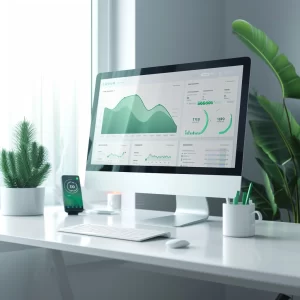T hese days, you hear a lot of negative comments about the frivolity of social media, but there is no doubt that these platforms can be a powerful driver of growth for businesses, particularly for ecommerce operations that use platforms like Shopify.
hese days, you hear a lot of negative comments about the frivolity of social media, but there is no doubt that these platforms can be a powerful driver of growth for businesses, particularly for ecommerce operations that use platforms like Shopify.
Social media connects brands with their audience and also serves as a vital conduit for personalized marketing and direct sales opportunities.
For Shopify store owners, understanding how to harness the capabilities of social media platforms can significantly enhance visibility and sales.
Let’s have a closer look at ways you can boost your social media efforts—by selecting the right social media channels, integrating them with Shopify, and accurately measuring the impact of these efforts through concrete metrics.
By optimizing these areas, businesses can create a vibrant online presence that engages customers and drives consistent revenue growth.
Selecting the Right Social Media Platforms
 “Social media” isn’t a monolith. Choosing the appropriate social media platforms is essential for deploying an effective marketing strategy. This decision should not be made lightly, as it can significantly influence the reach and effectiveness of your promotional efforts.
“Social media” isn’t a monolith. Choosing the appropriate social media platforms is essential for deploying an effective marketing strategy. This decision should not be made lightly, as it can significantly influence the reach and effectiveness of your promotional efforts.
The key is to understand where your target audience spends most of their time and how they like to engage with content.
For instance, visual platforms like Instagram and Pinterest are ideal for products that benefit from rich imagery, such as fashion and home decor.
These platforms allow for high visual engagement with products through posts and stories that can showcase style and detail. As one example, the Instagram Live feature offers a compelling way to reach an audience in real time, and it’s available to any business with access to a mobile device (desktop users must have a Professional Instagram account).

 Conversely, if your target demographic includes professionals or B2B customers, LinkedIn might be a more suitable choice. Here, the focus shifts to building professional credibility and networking, with content that often takes a more informative and less visually driven approach.
Conversely, if your target demographic includes professionals or B2B customers, LinkedIn might be a more suitable choice. Here, the focus shifts to building professional credibility and networking, with content that often takes a more informative and less visually driven approach.
For broader reach, Facebook/Meta remains an unequaled option, with its extensive user base (over three billion monthly users!) and advanced targeting options that allow for detailed customer segmentation through Meta Ads.
 Another important factor is the nature of your products and the story your brand wants to tell. Young, tech-savvy audiences might be more accessible on newer platforms like TikTok, where short, creative videos can go viral and reach millions of viewers overnight.
Another important factor is the nature of your products and the story your brand wants to tell. Young, tech-savvy audiences might be more accessible on newer platforms like TikTok, where short, creative videos can go viral and reach millions of viewers overnight.
Meanwhile, Reddit, with its vast number of community-specific forums, provides unique opportunities for precisely targeted campaigns (but be aware that these “subreddits,” as they’re called, often have restrictions on self-promotion).
Remember, on Shopify you can share product pages directly on the following platforms:
– Facebook/Meta
– Twitter/X
Selecting the right platform helps ensure that your social media efforts can generate maximum impact in the digital marketplace.
Integrating Shopify with Social Media
 Properly integrating Shopify with social media platforms can transform your marketing efforts from simple brand awareness to direct sales generation.
Properly integrating Shopify with social media platforms can transform your marketing efforts from simple brand awareness to direct sales generation.
Platforms such as Instagram and Facebook/Meta allow for the creation of shoppable posts and stores, where users can purchase products directly through the social media interface. This direct path to purchase simplifies the customer journey, potentially increasing conversion rates.
In order to sell on Meta, you’ll need to install Facebook and Instagram by Meta. This enables you to use the immensely useful Checkout on Facebook and Instagram feature, which allows your customers to purchase from you directly as they browse either of these two platforms.
Please note that this feature is not optional—starting on April 24, 2024, Checkout with Facebook and Instagram must be activated if you expect to sell products through Facebook. Be sure to take the time to learn how to process orders via this feature.
Integrations go beyond just this. Many businesses also use the Shopify Buy Button, which can be embedded into blogs, emails, or on other web pages, turning multiple points of content into potential points of sale.
For platforms that support it (like Pinterest), the Buy Button allows for effortless purchases, which is particularly effective for products that catch attention through lifestyle imagery and inspirational content.
Leveraging these integrated shopping features requires consistent updates and synchronization between your Shopify store and social media accounts to ensure inventory accuracy and to provide a smooth shopping experience.
Measuring Success with Relevant Metrics
 To gauge the effectiveness of your Shopify social media marketing efforts, it’s necessary to track specific metrics that provide insights into performance and return on investment (ROI).
To gauge the effectiveness of your Shopify social media marketing efforts, it’s necessary to track specific metrics that provide insights into performance and return on investment (ROI).
Utilizing Shopify’s integration with various analytics tools, including its own built-in features and third-party platforms like Google Analytics, can help merchants identify the most valuable data points for their campaigns.
– Engagement Metrics – These include likes, comments, shares, and overall post reach. High engagement rates often indicate that content really resonates with your audience, which is vital for building brand loyalty and driving organic growth through social platforms.
– Conversion Metrics – More critical than engagement, conversion metrics show the real impact of your social media efforts on sales. Key figures include click-through rates (CTR), which reveal how often people who view your posts go on to visit your Shopify store, and conversion rates, which measure the percentage of visitors who make a purchase. Tracking these metrics can help you pinpoint strategies that convert viewers into buyers more effectively.
 – Traffic Metrics – Assessing the volume of traffic coming to your Shopify store from social media platforms can help you understand which channels are most effective at driving potential customers to your site. Tools like UTM parameters can be instrumental in this process, allowing for detailed tracking of traffic sources.
– Traffic Metrics – Assessing the volume of traffic coming to your Shopify store from social media platforms can help you understand which channels are most effective at driving potential customers to your site. Tools like UTM parameters can be instrumental in this process, allowing for detailed tracking of traffic sources.
– ROI and Revenue Metrics – Ultimately, the success of your social media marketing on Shopify—and elsewhere—is measured by its return on investment.
This includes tracking the cost per click (CPC) of paid campaigns and the overall revenue generated from social media referrals. Understanding these figures is vital for determining the financial efficacy of your marketing spend and for making informed decisions about future investments in different social media channels.
Keeping Your Finger on the Pulse
In addition to these metrics, advanced analytics can provide deeper insights into customer behavior and preferences, enabling more targeted and personalized marketing strategies.
Regularly reviewing these metrics helps in optimizing current campaigns, and also in planning future roadmaps more effectively. By continually analyzing the success of social media activities, Shopify store owners can adjust their marketing efforts to better meet their goals and drive higher sales.
Looking to put a social media marketing plan for Shopify into action? The expert team at National Positions can help you design and implement the perfect social media marketing strategy for your growing business. Reach out today!